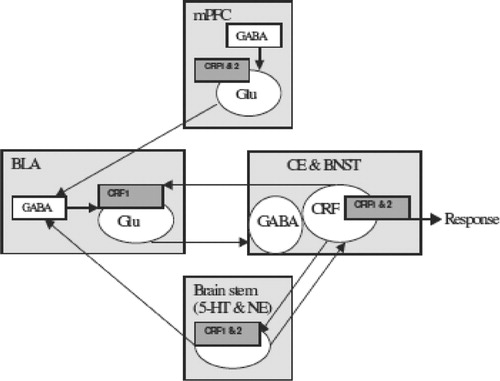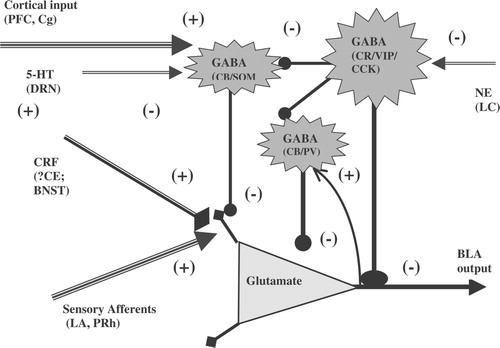Figures & data
Figure 1 A schematic representation of the sites of action of the CRF system within the amygdala and within an extended “emotional” network that may be involved in normal stress responses and may be critical in the development of chronic stress induced anxiety states. Many other regions modulated by the basolateral amygdala such as the nucleus accumbens and orbitofrontal cortex are not shown for the sake of simplicity and the limited focus on regions critical for anxiety-like behaviors. The central nucleus and the bed nucleus of the stria terminalis are presented as a single group since they have similar afferents from the BLA and efferent projections out of the extended amygdala. Projection neurons are presented as circles within the different brain regions. Abbreviations: BLA, basolateral amygdala; BNST, bed nucleus of the stria terminalis; CE, central nucleus of the amygdala; CRF, corticotrophin releasing factor; CRF1 and 2, CRF receptor types1 and 2; GABA, gamma aminobutyric acid; Glu, glutamate; 5-HT, serotonin; mPFC, medial prefrontal cortex; NE, norepinephrine.

Figure 2 A schematic drawing showing a highly simplified circuit within the BLA regulating emotional responses. The BLA is represented as a series of inhibitory cells ( − ) arranged around the projection neurons to integrate two sets of inputs: a stream of processed and direct sensory information (+; directly excitatory on the projection neurons) and the cortical input about predicted ability to cope with the given sensory inputs (inhibitory to the projection neurons; probably via the local inhibitory inputs). During chronic stress, in vulnerable individuals, the balance of these two inputs onto the projection neuron is disrupted, resulting in pathological anxiety and mood responses. Ascending serotonin and norepinephrine pathways provide modulatory tone that regulates this balance of stimulus and coping inputs, thus capable of up- or down-regulating the individuals ability to adapt to stress. The disruption of these modulatory mechanisms in extreme stress or in vulnerable populations, e.g. such as those with genetic polymorphisms in the monoamine modulatory systems, may also result in pathological stress reactivity. While this is clearly an oversimplification, similar principles can be applied to model the BLA function with multiple feedback loops containing many neurotransmitters and neuropeptides. Abbreviations: 5-HT, serotonin; BLA, basolateral amygdala; BNST, bed nucleus of the stria terminalis; CB, calbindin; CCK, cholecystokinin; CE, central nucleus of the amygdala; Cg, cingulate cortex; CR, calretinin; DRN, dorsal raphe nucleus; GABA, gamma-aminobutyric acid; HC, hippocampus; LA, lateral amygdala; LC, locus coeruleus; NE, norepinephrine; PFC, prefrontalcortex; PRh, perirhinal cortex; PV, parvalbumin; SOM, somatostatin; VIP, vasoactive intestinal peptide.
